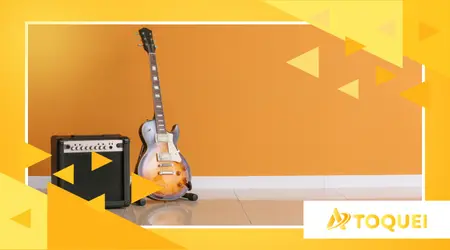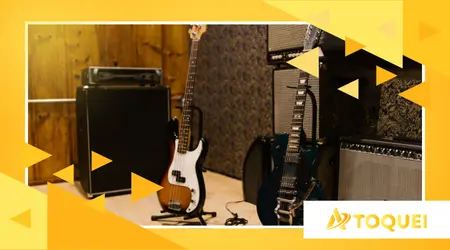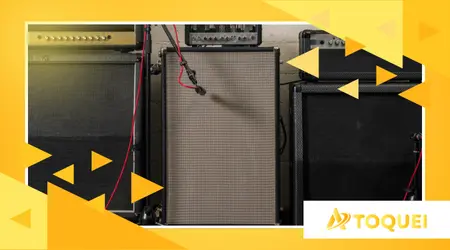The best guitar amplifiers for home studio

In the world of home music production, the search for the best guitar amplifiers for home studio has become a fundamental pillar for any serious guitarist.
Advertisements
The right choice is crucial, defining the color, texture and soul of your recording.
An ideal amplifier for the home studio needs to balance unquestionable sound quality, versatility, and the ability to operate at low volumes without sacrificing full-bodied tone.
Many inexperienced musicians underestimate the role of the amplifier in home studio. It's not just a volume-boosting device; it's the centerpiece of the guitar's sound creation.
The amplifier is an instrument in itself, responsible for shaping distortion, natural compression and dynamic playing response.
Advertisements
Skip this step and just rely on plugins can result in lukewarm, lifeless recordings.
For high-quality recordings, timbre capture needs to be authentic.
Even with the advancement of modelers, the sound and feel of playing through a good physical amplifier, or a high-fidelity modeler, remains unmatched.
The way it interacts with the guitar is vital, directly influencing the musician's performance.
Why have modeling amps become the norm in the home studio?

Digital modeling amplifiers have revolutionized home recording.
They offer a vast sonic library, emulating dozens of classic amplifiers in a single compact unit.
This versatility is an undeniable asset for musicians who need a broad tonal palette without crowding their studio space.
Portability and silent recording functionality are competitive advantages.
A modern modeling amplifier, such as a Kemper Profiler, Neural DSP Quad Cortex, or, at a more affordable price point, the Boss Katana, allows you to record directly on the audio interface.
++The best children's books about music to stimulate creativity
This eliminates the need to mic speakers in non-acoustically treated environments, solving the noise dilemma for apartment dwellers.
What are the best approaches to achieving professional tones in your home studio?

There are three main paths to achieving professional guitar tone at home: low-wattage tube amps, modeling amps, and cabinet simulators/pedals.
Low-Wattage Tube Amplifiers: The Classic Touch
For the purist, the tube amp is irreplaceable. 1- to 5-watt models, such as the Blackstar HT-1R MKII or the Vox AC4TV, allow the tubes to “work” at acceptable volumes for the home studio.
Read also: Is it worth buying a pedal board or separate pedals?
The warmth and organic saturation of tubes are difficult to replicate digitally. The key is to have a line output or a power soak integrated to attenuate the volume for recording.
Example 1: The blues-rock guitarist, looking for that “creamy” Marshall Plexi tone, might use a small 5W tube head connected to a power attenuator.
The power valve heats and compresses, delivering the sustain classic without the neighborhood calling the police.
The captured sound, even at low volume, carries the organic dynamics of the valve.
The Revolution of Modeling Amplifiers (Digital)
By 2025, modeling technology has reached an impressive level of realism.
++Digital piano reviews for beginners
Profiling modelers like Kemper can “capture” the sound of any physical amplifier with near-perfect accuracy.
High-end digital modelers, such as the Line 6 Helix line, offer built-in USB interfaces, turning them into dedicated audio interfaces for guitar.
The software market has also evolved. Platforms like Positive Grid BIAS FX 2 and Neural DSP Archetype continue to challenge physical hardware.
What's the big advantage?
Explore more: The 12 Best Guitar Amplifiers
Consistency. The timbre recorded in January will be identical to that recorded in December, without the variation caused by tired tubes or poorly positioned microphones.
Pedals and Cabin Simulators: The Ultra-Compact Solution
A notable trend is the use of high-quality pedal preamps or cab simulators (IR – Impulse Response).
Many guitarists prefer to plug a pedal with an excellent preamp (like the Strymon Iridium or the Universal Audio Dream '65) directly into their audio interface.
Analogy: Think of the pedal/simulator as an espresso capsule. It contains all the essence (the pre-filler and the cabinet) in a small format, delivering the flavor immediately.
THE guitar amplifiers for home studio it no longer needs to be a big box.
What are the essential technical features of a Recording Amplifier?
For recording, the focus should be on signal quality, not volume.
| Technical Appeal | Importance for Home Studio | Why It's Crucial |
| XLR DI Output (with Cabinet Simulation) | High | Allows silent and direct recording to the audio interface, with simulated snare drum tone. |
| Integrated USB Interface | Essential | Turns your amplifier into a sound card, making multitrack recording and re-amping. |
| Master Low Volume Control | Medium/High | In combo amplifiers, it allows the pre-amplification stage to be activated at low volume. |
| Effects Loop (FX Loop) | Average | Essential for inserting modulation and time effects (delay, reverb) after preamp saturation. |
Is it possible to reconcile cost-benefit and tonal excellence?
Yes, definitely. The price of admission for a good guitar amplifiers for home studio modeler is affordable, starting with the Fender Mustang LT25 or the aforementioned Boss Katana Mini.
This type of gear offers a ton of usable tones for a fraction of the price of a tube amp boutique.
The smart choice involves understanding your needs. For guitarists who play pop, rock, and metal, digital modeling offers the necessary flexibility.
For the jazz or blues musician who values the dynamics of subtle playing, perhaps the purity of a small tube amp with good pickup is the best route.
After all, why would we settle for an average timbre when excellence is within our reach in home studio?
Guitar Amplifiers for Home Studio: The Final Decision
There is no single “best” guitar amplifiers for home studio universal; there is the most suitable for your sound and space.
Whether it's the unparalleled flexibility of digital modelers or the irreplaceable warmth of small tube amps, your choice should amplify your creativity and respect your recording environment.
The 2025 market offers robust and intelligent options for all budgets, ensuring your guitar sounds with the intention and power your project deserves.
Frequently Asked Questions
What is Re-amping and why is it important in the Home Studio?
Re-amping is the process of recording the “clean” (DI) guitar signal first and then sending it back to an amplifier or modeler to apply tone and capture the processed audio.
This allows you to change the guitar timbre in the mix without the guitarist having to re-record the performance.
Can a 100 Watt amplifier be used in a Home Studio?
Not recommended. High-powered amplifiers need to be played at high volumes for the power stage (the output tubes) to saturate and deliver the best tone.
Using it at low volume results in a thin sound without ideal dynamics. Prioritize models with lower watts or excellent power attenuation.
Should I buy a Combo amp or separate head and cabinet?
For a small home studio, a combo amp (amplifier and speaker in the same box) usually offers better value and takes up less space.
If you opt for a head (just the amplification section), be sure to use a small cabinet (1x12 inch, for example) or, preferably, a cabinet simulator for direct recording.
